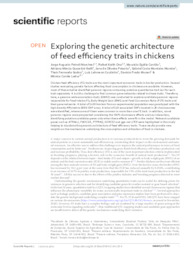Exploring the genetic architecture of feed efficiency traits in chickens.
Exploring the genetic architecture of feed efficiency traits in chickens.
Author(s): MARCHESI, J. A. P.; ONO, R. K.; CANTAO, M. E.; IBELLI, A. M. G.; PEIXOTO, J. de O.; MOREIRA, G. C. M.; GODOY, T. F.; COUTINHO, L. L.; MUNARI, D. P.; LEDUR, M. C.
Summary: Abstract: Chicken feed efficiency (FE) traits are the most important economic traits in broiler production. Several studies evaluating genetic factors affecting food consumption in chickens are available. However, most of these studies identified genomic regions containing putative quantitative trait loci for each trait separately. It is still a challenge to find common gene networks related to these traits. Therefore, here, a genome-wide association study (GWAS) was conducted to explore candidate genomic regions responsible for Feed Intake (FI), Body Weight Gain (BWG) and Feed Conversion Ratio (FCR) traits and their gene networks. A total of 1430 broilers from an experimental population was genotyped with the high density Affymetrix 600K SNP array. A total of 119 associated SNPs located in 20 chromosomes were identified, where some of them were common in more than one FE trait. In addition, novel genomic regions were prospected considering the SNPs dominance effects and sex interaction, identifying putative candidate genes only when these effects were fit in the model. Relevant candidate genes such as ATRNL1, PIK3C2A, PTPRN2, SORCS3 and gga-mir-1759 were highlighted in this study helping to elucidate the genomic architecture of feed efficiency traits. These results provide new insights on the mechanisms underlying the consumption and utilization of food in chickens.
Publication year: 2021
Types of publication: Journal article
Unit: Embrapa Swine & Poultry
Keywords: Frango de Corte, Ganho de Peso, Genoma, Genética Animal, Produção Animal
Observation
Some of Embrapa's publications are published as ePub files. To read them, use or download one of the following free software options to your computer or mobile device. Android: Google Play Books; IOS: iBooks; Windows and Linux: Calibre.
Access other publications
Access the Agricultural Research Database (BDPA) to consult Embrapa's full library collection and records.
Visit Embrapa Bookstore to purchase books and other publications sold by Embrapa.

